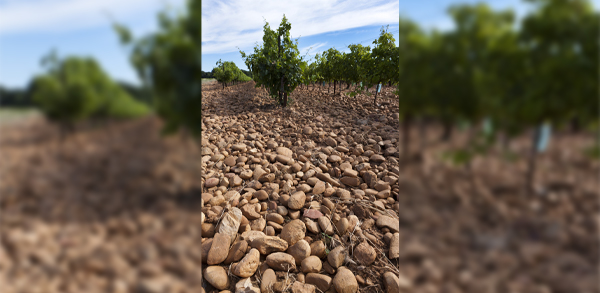Looking for a glass of warm, ripe red of authenticity and character?
You’ll always find one in the Côtes du Rhône, France’s second largest wine region.
Not only do they provide fruity, accessible flavour, they are some of the best value too.
Touching on a little bit of history
The region boasts winemaking back to 125 BC. The Greeks started the trend and it was taken up with gusto by the Romans. They used the Rhône valley as a thoroughfare. Always in need of ready access to good wine, they recognised the potential of the valley and planted vines along it.
Its glacial beginnings
To understand it, however, we need to go even further back than that, to the last Ice Age around a million years ago, when a glacier carved out what we now call the Rhône valley. Over centuries the Rhône river has continued the erosion as it wends its way south 812 kilometres, from its start in the Alps to the Mediterranean Sea.
Variety

Its expansive vineyards, straddling both sides of the river, may all come under the Rhône Valley Vineyards title, but within that, they deliver a range of styles. That is thanks to the region’s diversity of terroir (climate, soil, slope orientation etc) and the generations of growers and winemakers who have learnt how to make the most of what nature offers them.
The Rhône Valley – north and south
Linked by the river that runs through both, the regions north of Valence and south of it differ vastly in nearly every aspect. The northern part of the valley is very narrow with vineyards clinging to the slopes that lead steeply down to the river. Yields are low, and the work labour intensive. The climate is very different here too – continental, with hot summers and severe winters. Here, the Syrah grape thrives and makes fine, long-lived reds. Although Côtes du Rhône wines can be made in this northern stretch, the vast majority comes from south of Valence.
The magic of the south
That’s the point where the climate and landscape of the Rhône valley changes significantly. Being further south, the climate is naturally warmer and more moderate – Mediterranean, rather than continental, with hot summers and gentle winters. The number of hours of pure sunshine increase dramatically (it is one of the sunniest regions in all France). Meanwhile, the land broadens out with gentle slopes, rolling hillsides and near-flat plains, framed in the distance by the craggy peaks of mountains.
The prevalent Mistral
Then there is the Mistral – the constant strong wind that rules the landscape. It is said to drive many to madness. For the most part, however, it is a blessing. When it blows in spring, temperatures drop significantly, so that the vines bud later and avoid damaging frosts.
Read more: Discover the beautiful historical city of Avignon
Throughout the growing season, the wind helps to drive out the moisture and keep disease in the vineyards at bay. Perhaps most important of all, the Mistral sends the clouds scudding and welcomes in the sunshine to ripen the grapes to perfection. And you’ll find all that sunshine reflected in the warm, ripe fruit and generosity of its reds.
The grapes of the southern Rhône
As we leave behind the northern Rhône and move into the south, so we wave goodbye to Syrah as the dominant grape and Grenache takes over. Blended wine is the rule of thumb here, although Grenache nearly always makes up the lion-share. This variety makes soft spicy reds with lots of raspberry fruit and relatively high alcohol. To this, winemakers often add a little blackberry and herbal-scented Syrah and peppery, black fruit Mourvèdre, both of which bolster the Grenache with welcome tannins. They might also include a little Cinsault for freshness or Carignan for spicy black fruit, plus a few more small-time players besides these. But above all, Grenache is king.
This shift in grapes and climate accounts for a major change in wine style too. These Côtes du Rhône wines are more generous and expansive, softer, more velvety, with hints of the wild herbal garrigue. Wines that are delicious and ready to drink as soon as they are released. No waiting required. Within that there are a variety of styles and that is down to climate and, of course, soils.
Soils shaping wine styles

Close to the mountains, there is more limestone which produces wines that are elegant, firm and might need just a little ageing. Sandy soils are more prevalent elsewhere and make an easy-going fruity style of wine. On the terraces and the areas close to Châteauneuf-du-Pape, Gigondas, Rasteau and so on, the soil is strewn with big pudding stones or galets roulés. These accelerate the ripening and the result is a bigger, heartier and spicier style of wine – little brothers to Châteauneuf-du-Pape, Rasteau, Gigondas and such like. In the higher areas, close to regions like Ventoux and Tricastin, the climate is a little cooler and the red wines have a vibrant bite of freshness too.
The array of reds from the Côtes du Rhône offer a delicious entry into what the valley can offer. Great tasting wines for all occasions – appealing on their own and also with a whole variety of dishes … from rich meat to garlic and herb-laden stews, to everyday sausage and mash or cheeses.
From there you have a gateway to explore more of what the valley has to offer in its impressive pyramid of quality – the wines of Côtes du Rhône Villages, the cru villages that may add their names such as Chusclan, Plan de Dieu and Laudun, and the crus themselves like Rasteau. Whichever you choose, you can be sure of savouring the warmth and generosity of the region’s sun-filled Mediterranean climate.





